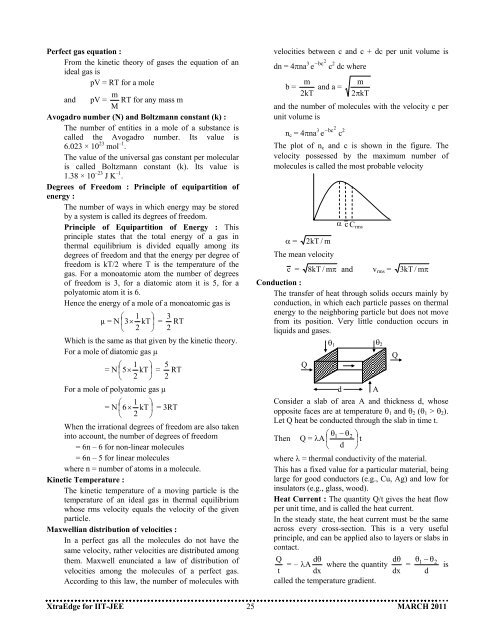March 2011 - Career Point
March 2011 - Career Point
March 2011 - Career Point
You also want an ePaper? Increase the reach of your titles
YUMPU automatically turns print PDFs into web optimized ePapers that Google loves.
Perfect gas equation :<br />
From the kinetic theory of gases the equation of an<br />
ideal gas is<br />
pV = RT for a mole<br />
and<br />
pV = M<br />
m RT for any mass m<br />
Avogadro number (N) and Boltzmann constant (k) :<br />
The number of entities in a mole of a substance is<br />
called the Avogadro number. Its value is<br />
6.023 × 10 23 mol –1 .<br />
The value of the universal gas constant per molecular<br />
is called Boltzmann constant (k). Its value is<br />
1.38 × 10 –23 J K –1 .<br />
Degrees of Freedom : Principle of equipartition of<br />
energy :<br />
The number of ways in which energy may be stored<br />
by a system is called its degrees of freedom.<br />
Principle of Equipartition of Energy : This<br />
principle states that the total energy of a gas in<br />
thermal equilibrium is divided equally among its<br />
degrees of freedom and that the energy per degree of<br />
freedom is kT/2 where T is the temperature of the<br />
gas. For a monoatomic atom the number of degrees<br />
of freedom is 3, for a diatomic atom it is 5, for a<br />
polyatomic atom it is 6.<br />
Hence the energy of a mole of a monoatomic gas is<br />
⎛ 1 ⎞ 3<br />
µ = N ⎜3 × kT ⎟ = RT<br />
⎝ 2 ⎠ 2<br />
Which is the same as that given by the kinetic theory.<br />
For a mole of diatomic gas µ<br />
⎛ 1 ⎞ 5<br />
= N⎜5 × kT ⎟ = RT<br />
⎝ 2 ⎠ 2<br />
For a mole of polyatomic gas µ<br />
⎛ 1 ⎞<br />
= N⎜6 × kT ⎟ = 3RT<br />
⎝ 2 ⎠<br />
When the irrational degrees of freedom are also taken<br />
into account, the number of degrees of freedom<br />
= 6n – 6 for non-linear molecules<br />
= 6n – 5 for linear molecules<br />
where n = number of atoms in a molecule.<br />
Kinetic Temperature :<br />
The kinetic temperature of a moving particle is the<br />
temperature of an ideal gas in thermal equilibrium<br />
whose rms velocity equals the velocity of the given<br />
particle.<br />
Maxwellian distribution of velocities :<br />
In a perfect gas all the molecules do not have the<br />
same velocity, rather velocities are distributed among<br />
them. Maxwell enunciated a law of distribution of<br />
velocities among the molecules of a perfect gas.<br />
According to this law, the number of molecules with<br />
velocities between c and c + dc per unit volume is<br />
dn = 4πna 3 2<br />
bc<br />
e − c 2 dc where<br />
m m<br />
b = and a =<br />
2kT 2πkT<br />
and the number of molecules with the velocity c per<br />
unit volume is<br />
n c = 4πna 3 2<br />
bc<br />
e − c 2<br />
The plot of n c and c is shown in the figure. The<br />
velocity possessed by the maximum number of<br />
molecules is called the most probable velocity<br />
α = 2 kT / m<br />
The mean velocity<br />
c =<br />
α c C rms<br />
8 kT / mπ<br />
and v rms = 3 kT / mπ<br />
Conduction :<br />
The transfer of heat through solids occurs mainly by<br />
conduction, in which each particle passes on thermal<br />
energy to the neighboring particle but does not move<br />
from its position. Very little conduction occurs in<br />
liquids and gases.<br />
θ 1 θ 2<br />
Q<br />
d A<br />
Consider a slab of area A and thickness d, whose<br />
opposite faces are at temperature θ 1 and θ 2 (θ 1 > θ 2 ).<br />
Let Q heat be conducted through the slab in time t.<br />
⎛ θ1 − θ2<br />
⎞<br />
Then Q = λA ⎜ ⎟ t<br />
⎝ d ⎠<br />
where λ = thermal conductivity of the material.<br />
This has a fixed value for a particular material, being<br />
large for good conductors (e.g., Cu, Ag) and low for<br />
insulators (e.g., glass, wood).<br />
Heat Current : The quantity Q/t gives the heat flow<br />
per unit time, and is called the heat current.<br />
In the steady state, the heat current must be the same<br />
across every cross-section. This is a very useful<br />
principle, and can be applied also to layers or slabs in<br />
contact.<br />
Q dθ dθ θ<br />
= – λA where the quantity =<br />
1 − θ 2<br />
t dx<br />
dx d<br />
called the temperature gradient.<br />
Q<br />
is<br />
XtraEdge for IIT-JEE 25 MARCH <strong>2011</strong>

















